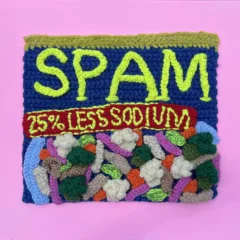Art and the US Food Supply Chain
My life was radically altered a few years ago when my then-vegan daughter took my wife and me to see a film — “Speciesism” — which spotlights, among other things (including the proposition that non-human animals are sentient beings), the horrors of industrial farming in the United States. Indeed, my wife has not consumed meat since that evening, nor I chicken. How Food Moves: Edible Logistics, the new exhibit at Rowan University’s Art Gallery, did not have that powerful an effect upon me, but it is an extremely informative experience — in many respects like a science expo — that explores the narrative of how the US food supply chain works as it weaves between the farm and the plate, and connects what you might experience as local parts of the food chain to the global economy.
Of course, there is a long history of food in art, of food consumption and distribution in art, and importantly, of laborers and migrant workers depicted in art. And in this exhibition, which presents a variety of installations, displays, photographs and videos, there is an admixture of art and . . . . I’m not quite sure how to characterize it – art and science, art and social justice, art and economics, art and politics, all about the food chain. In many of the pieces, the artistic mélange illuminates the subject. In others, however, the subject matter is technical and the presentation science-fair-like, overshadowing the artistic components. The material overall is provocative and intensely interesting, but this is no traditional art exhibit.
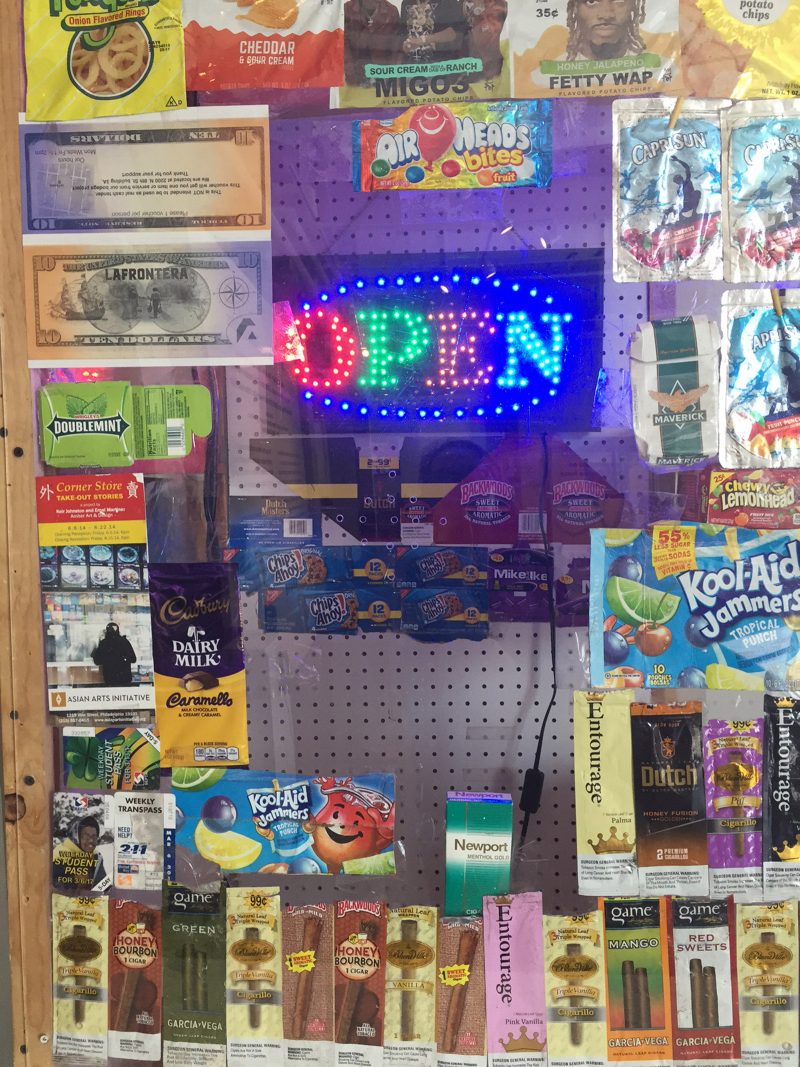
The food desert
You will be moved, if by nothing else, by sections of the exhibit that address the issue of “food deserts,” low income neighborhoods in Philadelphia and elsewhere where there is little-to-no access to fresh, nutritious foods. I’ve included here an image from “Store: Takeout Stories,” created by Amber Art & Design and the Asian Arts Initiative, a installation which highlights the paltry and disturbing selection of items that you might find in the corner store in a food desert.
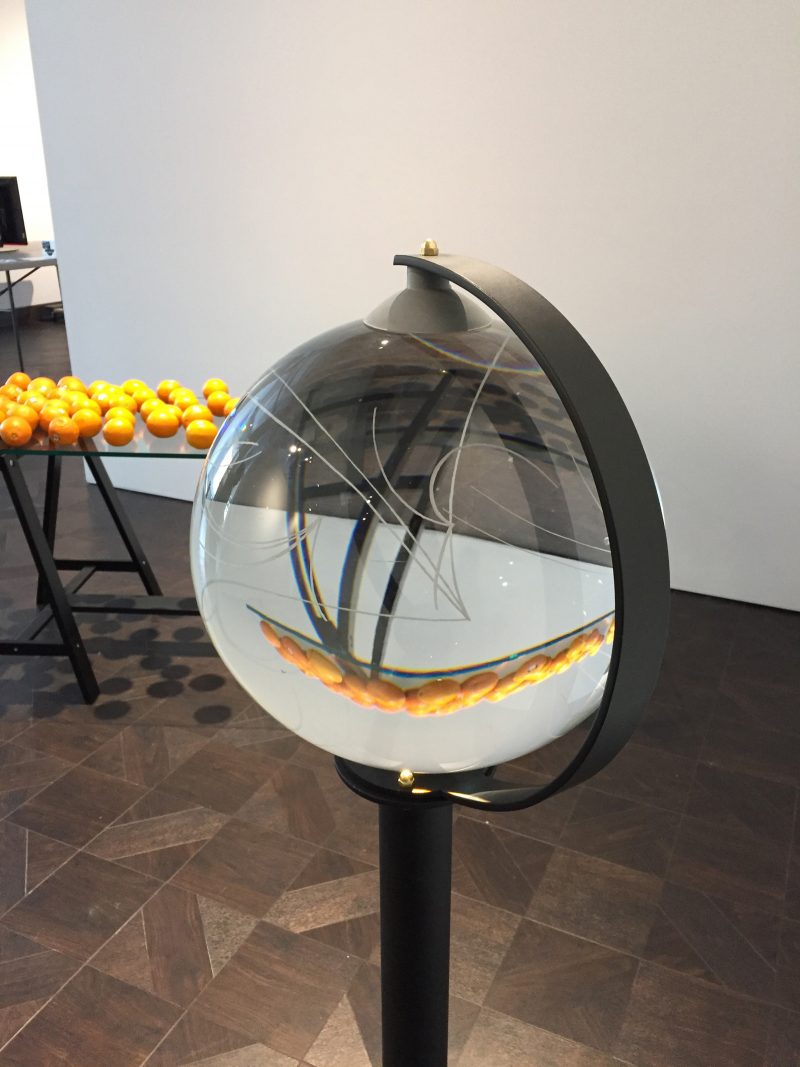
“…oranges that come all the way from China”
One of the first things that captures your attention in the gallery is a table of oranges (including a “Take One” sign) that sits beside a water-filled clear glass globe etched by the artist to trace the path of oranges around the world. This is an installation by Philadelphia artist Kristen Neville Taylor called “Suzanne” (2017), which was inspired by the line in Leonard Cohen’s song of the same name — “and she feeds you tea and oranges that come all the way from China.” Each of the oranges has an artist-created QR code sticker (a type of barcode that connects to the internet), which when scanned through a smartphone app links you to webpages with several orange-related items: Nina Simone’s version of “Suzanne,” a handful of articles about migrant movements in the orange economy, and folk tales and artworks that include oranges. Neville Taylor invites you, with a dose of exoticism, to consider the winding path that ends with an orange on your table.
The story of Beardstown, Illinois
Beardstown is a small, rural town which sits in the middle-western part of the state on the Illinois River. It’s about 125 miles north of St. Louis, and is home to two icons of global agribusiness: enormous grain terminals and a massive pork slaughterhouse and processing plant (formerly owned by Cargill Inc., now by a Brazilian conglomerate).
How Food Moves includes a compelling film, projected on a wall of the gallery, about the town, — “Between the Bottomlands & the World,” (2015) — which is part of project by two Illinois educators, Ryan Griffis (University of Illinois, Urbana-Champaign), and Sarah Ross (School of the Art Institute of Chicago).
The film is divided into three acts: Submerging Land, which shows how the landscape of the town has been massively engineered and transformed to redirect water for the production of commodity crops; Granular Space, a meditation on the international grain trade — from seed to tanker; and Moving Flesh, which chronicles the migration of workers to Beardstown from all over the world and documents the radical demographic transformation of a community that was once an all-white “Sundown town.”
The film, which is over an hour long (but is available online), is informative, thoroughly engaging, disturbing, even heartbreaking, and, at times, heart warming. The portrayal in Moving Flesh of the ups and downs in the lives of migrants / immigrants who were lured to the town by agribusinesses is particularly poignant, as well as timely.
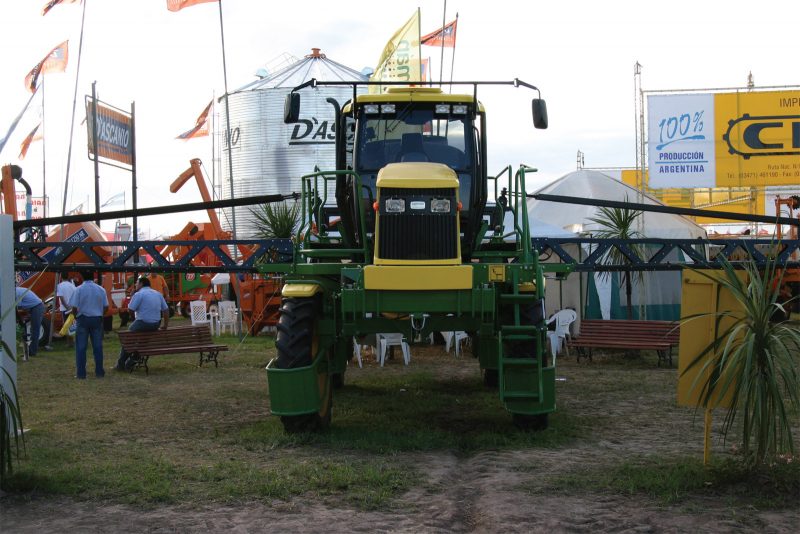
The heavy equipment of industrial farming
Perhaps the most striking pieces in the show are the photographs by another Illinois educator, Claire Pentecost, entitled “ExpoChacra, Agricultural Trade Show, Argentina” (2005). The color photos depict monstrous farm machinery (tractors, cultivators, combines, plows, reapers, harrowers) which suggest insects blown up to the size of giant helicopters. The work is surprisingly intimate — it slaps you in the face — and you are likely to feel either horrified or enthralled by the sheer scale of the equipment and by the image of these almost otherworldly devices which tear up the land and render humans dwarfed and powerlessness.
The message: that throughout the food supply chain we are at the mercy of global manufacturers, banks and financiers who enable and ultimately control big agribusiness and whose intent is defined solely by profit.
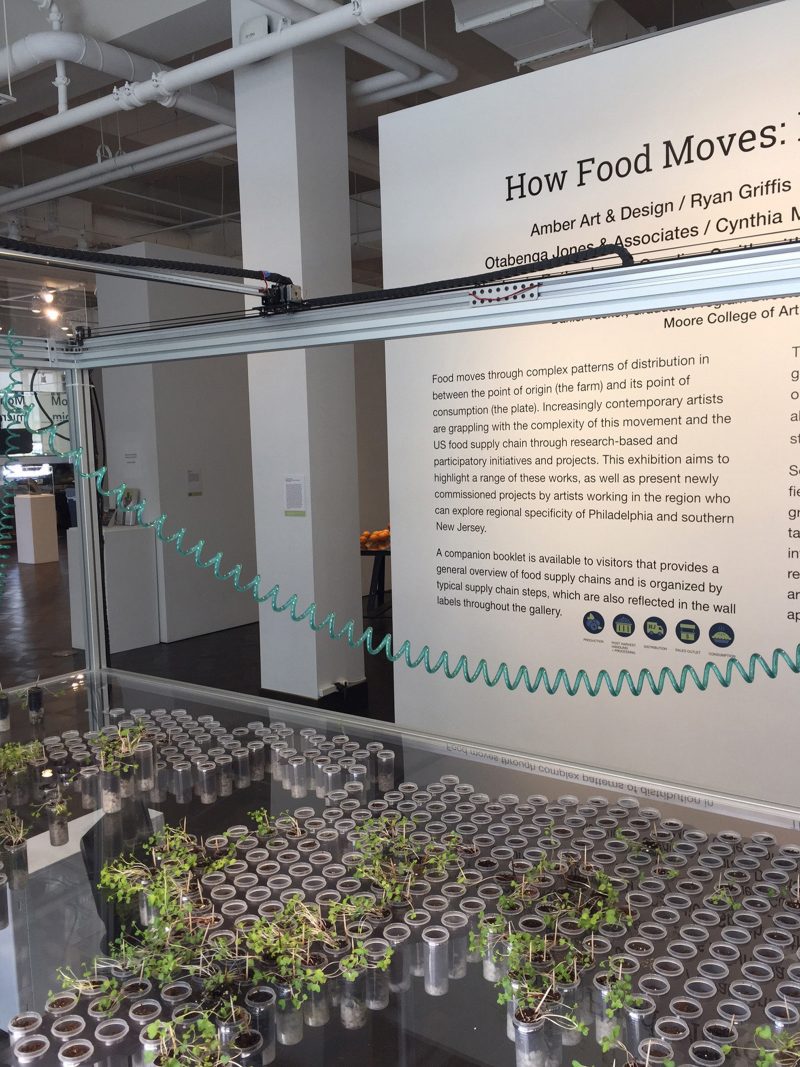
Microfinance – the hidden costs
Let me mention one of the displays that I found somewhat befuddling – “Reversal of Fortune: The Garden of Virtual Kinship” – by Stephanie Rothenberg, who teaches at SUNY Buffalo. This is an intriguing (“what is that?”) installation — an example of what seemed to me more like science fair than art — that purports to demonstrate the high cost of online crowdfunded micro-financing in the world of small scale entrepreneurship, including local agriculture and farming.
In the installation, pictured here, a computerized system sprinkles a garden of containers that represent small time borrower / entrepreneurs (many of them in the developing world), which are laid out in a nondescript world map grid. Only some of the containers have sprouting plants, which represent successful ventures. The others are barren, apparently representing projects or areas in which the system has been unsuccessful. There also are two digital meters attached to the exhibit: one which reports crowdfunded dollar donations, and the other which contrasts those amounts with the associated exorbitant interest charges imposed by the entities that control this form of micro-financing.
I found the installation slightly confusing; and it troubled me that it did not clarify the extent to which this type micro-financing plays a role in the global food economy. Still, it was thought provoking. And it was discouraging to learn that the hidden interest charges involved substantially undermine this potential lifeline to small scale entrepreneurs in the food chain. Finally, and unfortunately, I did not find the artistic expression either illuminating or compelling.
New Jersey blueberries
How Food Moves: Edible Logistics is accompanied by a small companion booklet authored by Megan Bucknum Ferrigno, who teaches in the Department of Geography, Planning and Sustainability at Rowen. The booklet traces the food chain of the New Jersey-grown blueberry from a bush in Hammonton to a blueberry pie enjoyed in Glassboro, and serves, among other things, as a guidepost to the steps of the food chain that are touched upon in the exhibition.
How Food Moves: Edible Logistics was curated by Daniel Tucker, Graduate Program Director in Social and Studio Practices at Moore College of Art and Design, and is part of Rowan’s series, organized by gallery director Mary Salvante, highlighting artist activists. Other artists / groups included in the exhibition are Brian Holmes, Otabenga Jones Associates, Cynthia Main, Philly Stake, and Candice Smith with Freedom Arts.
While the exhibition is heuristic, and requires a considerable investment of time to appreciate, it concerns subject matter that is, and certainly should be, important to us all – where our food comes from. The show will be up through May 27th at the Rowan University Art Gallery. It’s well worth the journey.


